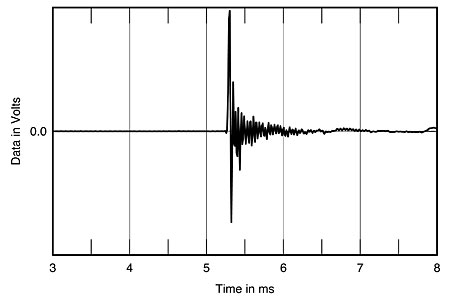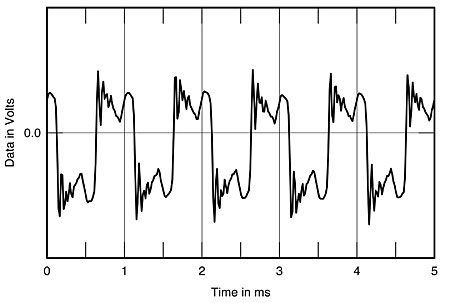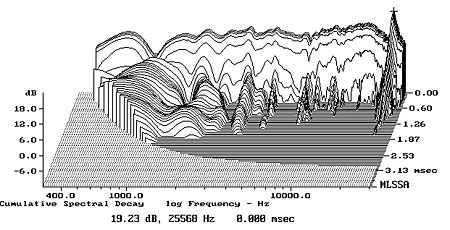| Columns Retired Columns & Blogs |
Thiel CS5 loudspeaker Measurements
Sidebar 2: Measurements
Footnote 1: The problem with trying to look at the anechoic section of a loudspeaker's impulse response in a normal room is that the further away you move the microphone from the speaker, the smaller the time window between the moment the pulse reaches the mike and the first reflection of that pulse from the nearest surface, usually the floor. Normally, I use stands to raise a floorstanding speaker some 48" off the ground to make MLSSA measurements, as frequency resolution is inversely proportional to the length of the reflection-free time window. Given, therefore, that the 180-lb CS5 could not easily be raised off the floor, placing the microphone at the full 3m demanded by Thiel would unfortunately reduce resolution to the point of vanishing returns. All these measurements, therefore, represent to a greater degree than normal a necessary compromise between the demands of absolute precision and the inadequacies of the real world.—John Atkinson
Looking at the CS5's impedance (fig.1), it can be seen that the CS5 presents an amplifier with a pretty severe load, dropping under 4 ohms in the lower midrange and below, as well as at 2kHz. In fact, disregarding the slight phase lag in fig.1 in this region, the speaker pretty much approximates a 2 ohm resistor throughout the bass, which means that the amplifier with which it is used must have ample—to say the least—current capability if the sound is not to become anemic. In addition, if the preamp doesn't have some sort of subsonic high-pass filter on its phono input, record warps could cause amplifiers with limited current delivery to become starved in the low bass, with a potentially disastrous effect on dynamics. In addition, it is to be expected that the effect of cables on the speaker's sound will not be trivial; the overall rise in impedance with frequency also suggests that amplifiers with highish output impedances—a typical tube design, for example—will tend to sound tilted up in the treble with the CS5.

Fig.1 Thiel CS5, electrical impedance (solid) and phase (dashed). (2 ohms/vertical div.)
Turning to the speaker's time-domain performance (synthesized by the DRA Labs MLSSA—pronounced "Melissa"—system): the output of the CS5 70" away on the lower-midrange axis (38" off the floor) when fed a very narrow rectangular unidirectional pulse, is shown in fig.2. (Though Jim Thiel is adamant that the CS5 should be measured at a distance of 3m or 10' to get the correct balance between the lower midrange and the treble, this was unfortunately impossible in my room or even in Larry's, footnote 1) Though overlaid with ultrasonic ringing from the metal-dome tweeter, the sharp up/down shape with minimum time smear suggests that although the speaker is a five-way design, the contributions from all five drivers do arrive at that point in space at effectively the same time, thanks to the sloped baffle and the use of first-order crossover filters. For comparison, moving the microphone down 5" gives the impulse shape shown in fig.3, where the output from the lower-midrange unit can now be seen to precede the higher-frequency drivers.

Fig.2 Thiel CS5, impulse response on lower-midrange axis at 48", 38" from the floor (5ms time window, 30kHz bandwidth).

Fig.3 Thiel CS5, impulse response below lower-midrange axis at 48", 33" from the floor (5ms time window, 30kHz bandwidth).
The CS5's step response on the lower-midrange axis is shown in fig.4. It demonstrates a good, time-coincident, arrival of the upper-frequency drive-unit outputs, with then multiple arrivals of the woofer outputs.

Fig.4 Thiel CS5, step response on lower-midrange axis at 48" (5ms time window, 30kHz bandwidth).
The CS5's acoustic phase response at the original microphone position is shown in fig.5. Though this can be seen to lag a little at high frequencies at this mike position, reaching a full 180° at 15kHz or so, this is still excellent performance, as can be seen by comparing it with fig.6, which shows the phase response of the two-way Acoustic Energy AE2 loudspeaker I reviewed in the February issue. (These "wrapped" responses show –180° phase lag to be equivalent to +180° phase lead, thus allowing the entire response to be conveniently plotted on a ±180° scale.) In effect, the AE2's phase response lags by 540° at 20kHz compared with the CS5's 255°.

Fig.5 Thiel CS5, phase response on lower-midrange axis at 70" (corrected for the time taken for sound to reach the mike).

Fig.6 Acoustic Energy AE2, phase response on listening axis at 48" (corrected for the time taken for sound to reach the mike).
The MLSSA system can also calculate the departure of the phase response from that of a minimum-phase system, which is one that has the "correct" amount of phase error for its particular amplitude response. This "excess" phase is shown in fig.7: the –160° excess phase at 20kHz is trivial in that it means the effective source position at this frequency is just under 1/3", or 8mm, further away from the microphone at its particular position. It is not inconceivable that this small amount of excess phase could be removed by even a slight change in microphone position—the mike position is incredibly critical at this too-near measuring distance—meaning that the CS5, as implied by its specification—±5° excess phase—is truly a wideband, minimum-phase loudspeaker.

Fig.7 Thiel CS5, excess phase response on lower-midrange axis at 70".
This excellent phase performance means that the CS5 should have no trouble producing an acoustic squarewave. However, finding the exact position in space where all the drive-unit outputs arrive coincident in time is difficult in a real room. Fig.8 shows the best that J. Gordon Holt and I were able to do with a 1kHz squarewave without the benefit of a real-time 'scope display to give us instantaneous visual feedback of what we were doing. (For reference purposes, fig.9 shows the 1kHz squarewave produced by that superb time slicer, the Quad ESL-63, also at a 48" distance.) Some ringing is apparent on the tops of the CS5 waveform, and the slope of those tops suggests a lower-midrange suckout at that too-near point in space as predicted by the Thiel "White Paper."

Fig.8 Thiel CS5, typical 1kHz squarewave response (30kHz measurement bandwidth).

Fig.9 Quad ESL-63, typical 1kHz squarewave response (15kHz measurement bandwidth).
However, note how beautifully sharp the leading edges of the waveform are, confirming what is really a superb impulse response for a moving-coil loudspeaker. It is said that such time coherency is not subjectively important, particularly given that its achievement is so dependent on listening/measuring position. (One of life's ironies is that Quad's Peter Walker, designer of a speaker which can very easily produce acoustic squarewaves, is one of those who holds that it is not important.) Yet, along with Larry Archibald, I can't help but suspect that it must contribute to the exquisite sense of image space and depth wrought by the CS5s when listened to on the optimal axis.
Turning to the frequency domain, the righthand side of fig.10 shows the CS5's on-axis frequency response, averaged across a 30° horizontal window on the listening axis, calculated by MLSSA from the anechoic (reflection-free) portion of the speaker's impulse response and plotted from 250Hz to 20kHz. The microphone was moved nearer than before, to 48", to try to get a little more midrange resolution—the speaker's bulk meant that it was not possible to raise it far enough from the floor to get reliable data much below 700Hz—and at this particular mike position, a suckout appears in the midrange, presumably due to interference between the 8" woofer and 5" cone midrange unit. The treble region will also be boosted a little at this distance. Apart from these problems, however, which are related not so much to the speaker but to the measurement technique and will not exist at the suggested 3m listening and measuring distance, note how smooth the response trend is throughout the entire treble. On the appropriate listening axis and at the correct distance, the CS5 will be flat.

Fig.10 Thiel CS5, anechoic response on lower-midrange axis at 48", averaged across 30° horizontal window and corrected for microphone response, with the nearfield responses of midwoofer (blue) and upper subwoofer (red) plotted below 300Hz.
Jim Thiel's use of first-order crossover filters, however, does mean that this listening axis is critical vertically. Fig.11 plots the responses 3" below the lower-midrange axis (rear), on the lower-midrange axis (second to rear, same as fig.10), on the midrange-dome axis (second to front), and on the tweeter axis (front), all taken at a 48" mike distance. Sit a little too low, and the low treble becomes accentuated, the sound becoming rather bright (this was something JGH, who is hardly Kareem Abdul Jabbar, noted during his auditioning); sit slightly too high and the mid-treble lacks energy; sit very high or stand up, and the sound will be thin in the highs and lean in the midrange. As with the Spica TC-50, therefore, the worst way to form a judgment on the CS5's sound is simply to walk into a room where they're playing and stand at the back without sitting down, as many critics (who should know better) are wont to do.

Fig.11 Thiel CS5, vertical response family at 48", normalized to response on lower-midrange axis, from back to front: differences in response 5° below lower-midrange axis, reference response, differences in response 5–10° above axis.
I also suspect that part of the reason for the relative lifelessness of the CS5s in my listening room is due to the nature of these responses vertically off-axis. In a smallish room—and that term has to be relative, my room still being reasonably generously sized compared with those possessed by many of Stereophile's urban readers—I conjecture that the reverberant soundfield in the room will feature a lack of energy in the regions which would otherwise contribute to a sense of subjective "life" to the sound, even though the CS5's on-axis response is as flat as a typical power amplifier's.
On the other hand, the CS5 features excellent lateral dispersion. Fig.12 shows the difference between the anechoic response measured on the speaker's lower-midrange axis at a 48" measuring difference and that 15° laterally off that axis. Note that, apart from a slight lack of energy in the top two audio octaves, the on- and off-axis responses are essentially identical. This will mean that although the reflections of the CS5's sound from side walls will not be as colored as they are with conventional loudspeakers, its wide dispersion means that these reflections will be stronger in high-frequency content and will probably, therefore, have a greater disturbing effect on imaging integrity. With the speakers placed close to the walls, it will be essential to toe them in to the listening position.

Fig.12 Thiel CS5, difference in anechoic response on lower-midrange axis made by moving mike 15° off-axis laterally.
Returning to fig.10, the lefthand side of the graph shows the individual responses of the mid-woofer and the upper of the two subwoofers measured in the nearfield. As specified, the crossover between the units can be seen to occur at exactly 50Hz. In-room, these measurements translate to flat extension to 25Hz or so, provided, of course, that the amplifier has enough current reserve in this region to allow the sound to develop fully.
Finally, MLSSA's post-processing capabilities allow you to examine, in effect, how the frequency response of the speaker changes as the sound dies away, revealing the presence of resonances as "ridges" parallel to the time axis. The resultant "waterfall" plot for the CS5 is shown in fig.13, and is remarkably clean. The sharp-peaked ridge at 26kHz is due to the tweeter's "oil-can" resonance and is subjectively innocuous, though the slight ridges in the treble—at 3460Hz, 5060Hz, and 9410Hz—might correspond with the slight hardening of the sound that LA noted at very high playback levels.

Fig.13 Thiel CS5, cumulative spctral-decay plot on lower-midrange axis at 48".
All in all, the CS5 is both the most thoroughly worked-out speaker design I have ever come across and perhaps the best-measuring loudspeaker I have yet experienced. Which makes it all the more galling that I couldn't get it to sing in my own listening room.—John Atkinson
Footnote 1: The problem with trying to look at the anechoic section of a loudspeaker's impulse response in a normal room is that the further away you move the microphone from the speaker, the smaller the time window between the moment the pulse reaches the mike and the first reflection of that pulse from the nearest surface, usually the floor. Normally, I use stands to raise a floorstanding speaker some 48" off the ground to make MLSSA measurements, as frequency resolution is inversely proportional to the length of the reflection-free time window. Given, therefore, that the 180-lb CS5 could not easily be raised off the floor, placing the microphone at the full 3m demanded by Thiel would unfortunately reduce resolution to the point of vanishing returns. All these measurements, therefore, represent to a greater degree than normal a necessary compromise between the demands of absolute precision and the inadequacies of the real world.—John Atkinson
- Log in or register to post comments




































